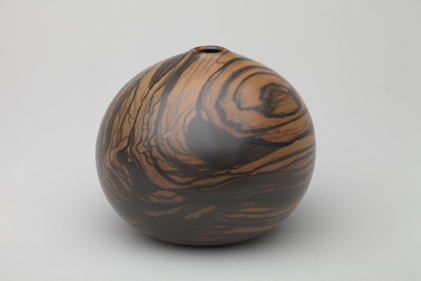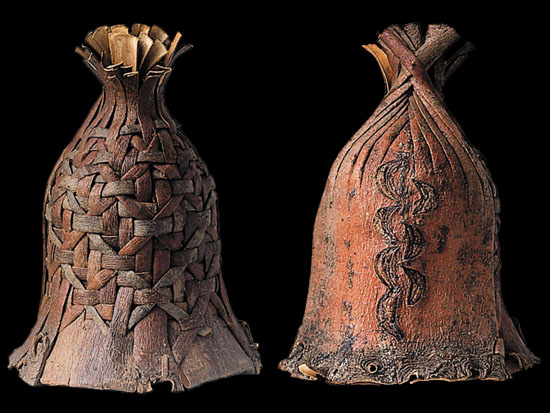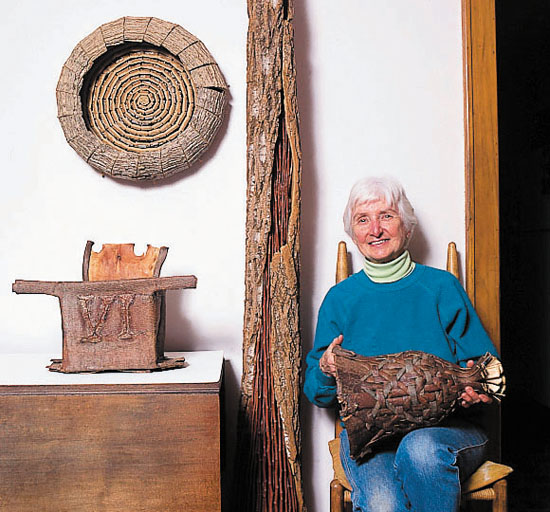Dorothy Gill Barnes and David Ellsworth are drawn to working with wood to create sculptural forms, however each has a different approach to using the material. Collection Focus: Dorothy Gill Barnes and David Ellsworth at the Racine Art Museum in Wisconsin spotlights the use of organic materials, primarily wood and bark of various trees. Although each artist’s work is very different in terms of structure and the process of creation, their sculptural objects and vessels will be displayed together to establish a visual and critical survey of their similarities and differences.
Although Dorothy Gill Barnes is usually categorized as a fiber artist, RAM’s collection of her work concentrates on sculptures she has created from trees, especially from their bark and limbs. Barnes is known for developing a distinct working process that includes scarring trees that have been marked for eventual removal and, returning years later after the trees have been cut, harvesting the grown bark as a decoratively scarred skin to use in her baskets. This technical advancement enables her to create dendroglyphs—literally, “tree drawings.” This is a process in which Barnes makes careful incisions into the bark of a living tree. Over time, it forms a scar around her designs—the tree and time both becoming collaborators with the artist, with the process taking anywhere from a few months to 17 years. Barnes’ early influences were the artist and teacher Ruth Mary Papenthein, who taught at Ohio State University, and Dwight Stump, an Ohio-based traditional basket maker. She also credits the works of John McQueen and Ed Rossbach as setting a standard for experimenting with natural materials to make contemporary sculpture.
Barnes eventually taught fibers as an adjunct faculty member at Capital University in Columbus, Ohio, from 1966 until her retirement from university teaching in 1990. Throughout much of her career, Barnes has also been a sought-after teacher who has traveled across the US and around the world conducting classes and residencies.The work of Dorothy Gill Barnes is the realization of a combination of sources and technical investigations that have placed her at the forefront of contemporary fiber art.Beginning with traditional basketry techniques and their dedication to the container form, she has steadfastly advanced through a career-long process of experimentation to become known around the world for her sculptures that utilize bark cultivated from trees.
Barnes uses electric tools to expand the scale, scope, and complexity of her pieces and she credits power equipment as the source for ideas that handwork alone would not have suggested. She is comfortable employing nails, metal wire, and staples along with traditional woven assembly methods. In all of her sculptures, Barnes seeks to create structures that honor the growing things from which they came. She highly prizes experimentation, spontaneity, inventiveness, and an openness to the wood and the process that is both intellectually playful and leaves her open to changes in the composition that nature offers. Barnes’ work is also included in Green from the Get Go: International Contemporary Basketmakers at the Wayne Art Center in Pannsylvania through January 21st.

David Ellsworth Vessel, 1987 Macassar ebony Racine Art Museum, Promised Gift of Jane and Arthur Mason Photography: Jon Bolton, Racine, WI
David Ellsworth is an influential presence in the modern wood turning community. He has both channeled and challenged the idea of functional turned wood vessels. At one point, he began creating his own bent turning tools to achieve his conceptual and aesthetic goals. Principles of design and working with clay have been important in the formation of his artistic concepts and approaches. Ellsworth has long been inspired by a wide range of objects and philosophies, finding direction from artists such as sculptor Mary Frank, woodworker James Prestini, and ceramics artist Paul Soldner and valuing the design and “spirit” of Native American art and architecture. In the last ten years, the Racine Art Museum has acquired over 40 works by Ellsworth—with a sizable number of pieces created over a broad spa, both small and large scale.
The exhibition ends January 15th. Racine Art Museum, 441 Main Street, Racine, Wisconsin 53403, 262.638.8300.


